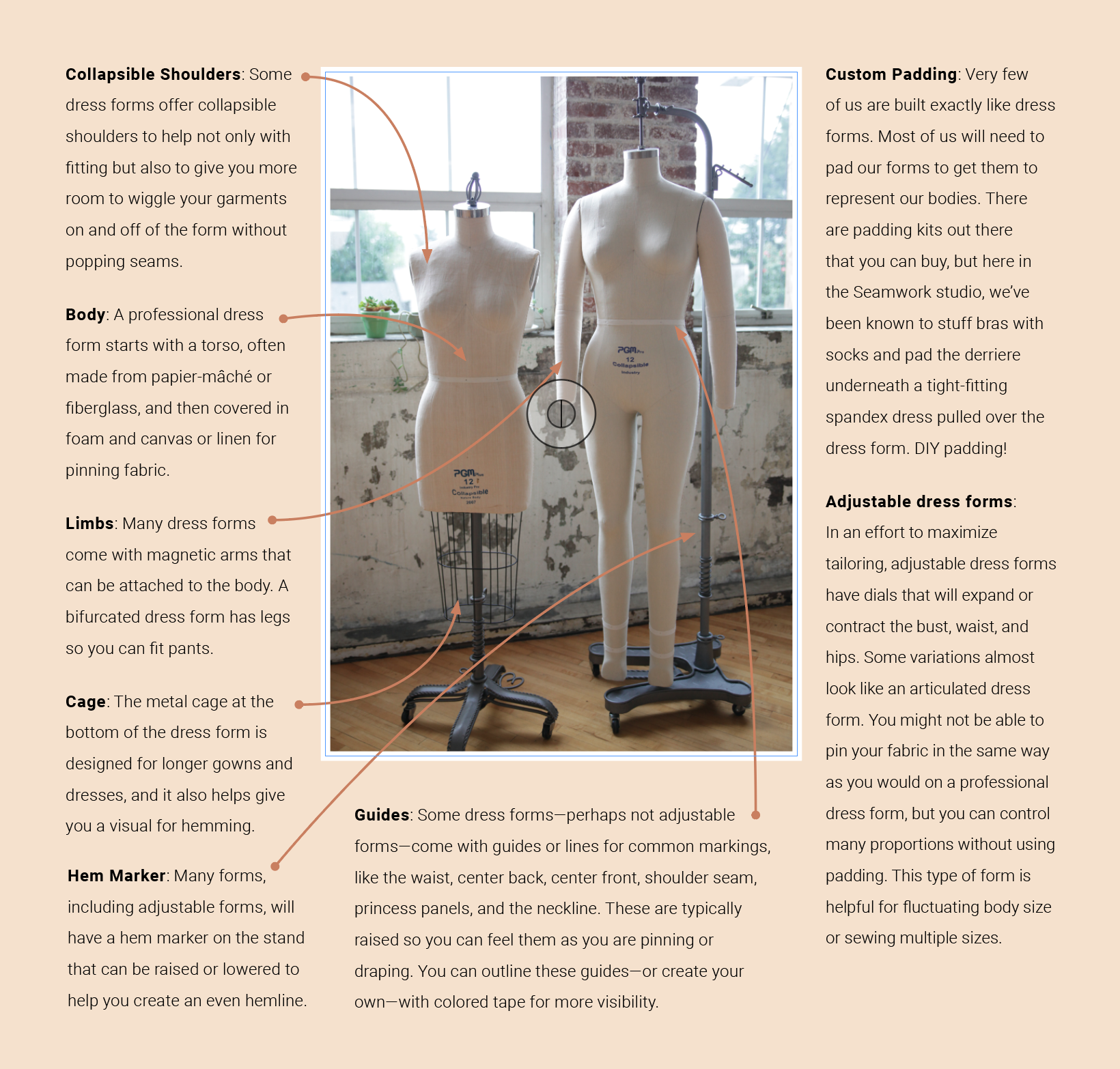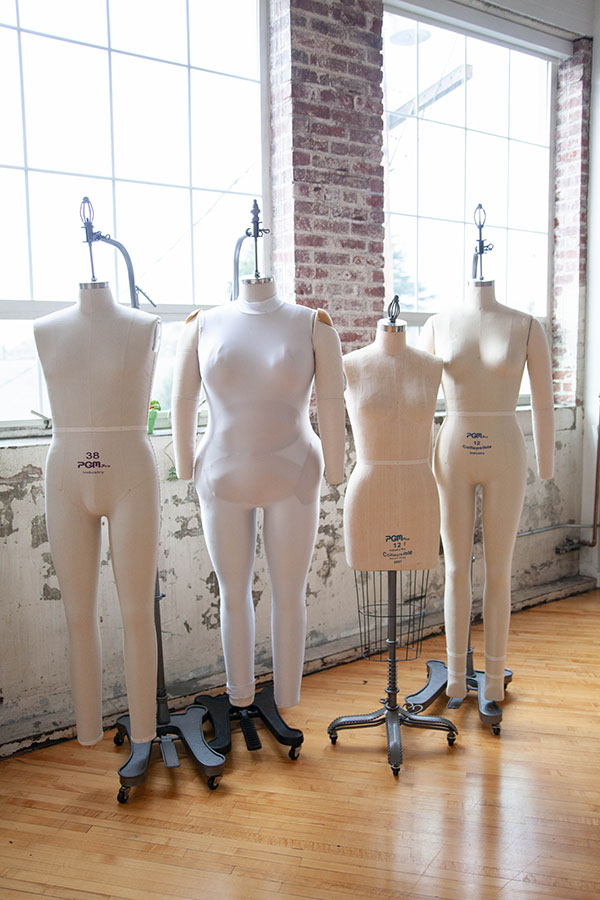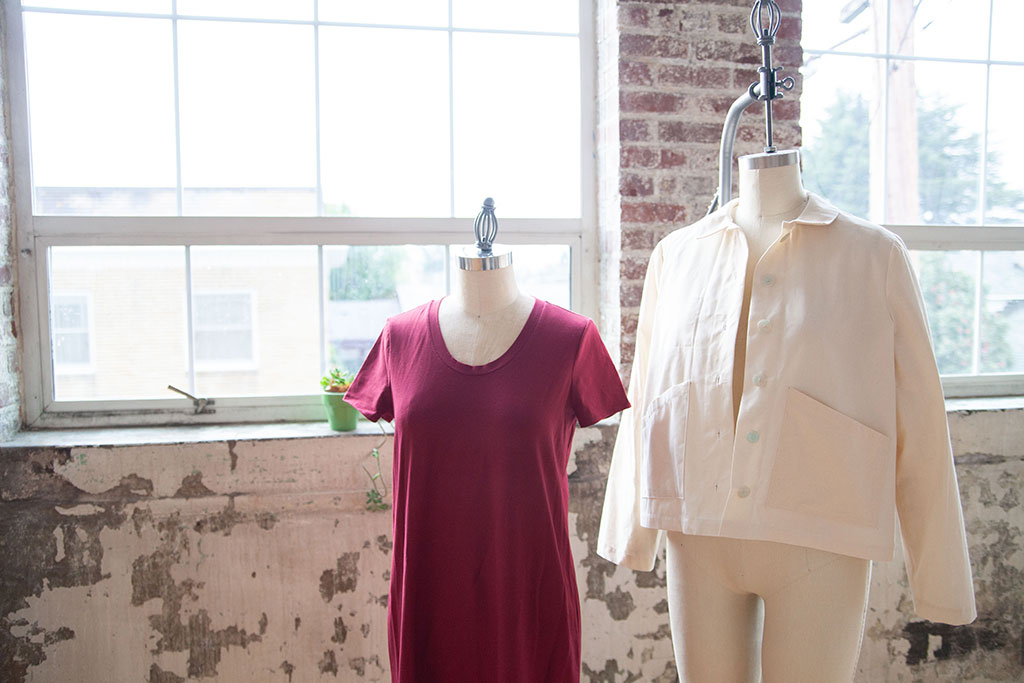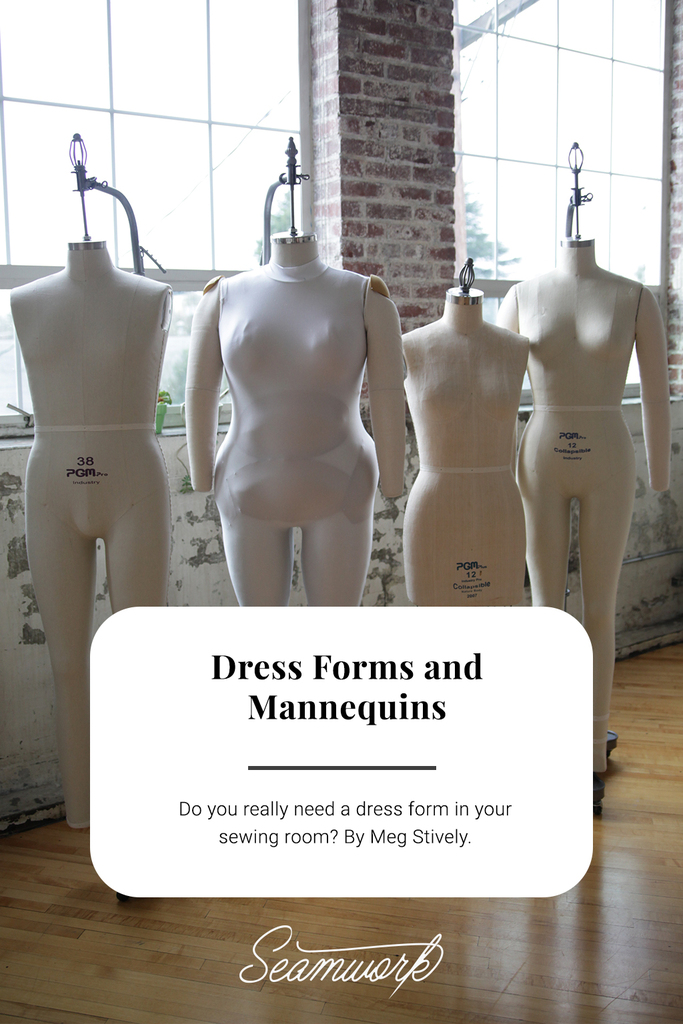
There’s a difference between the dress forms used for tailoring and the mannequins displaying clothing in storefronts—the former has remained quite the same over the years, and the latter changes with the seasons. Dress forms help with tailoring and fit, and mannequins sell a fantasy.
Dress forms are one of the most recognizable symbols of fashion. You’ll see them romantically depicted in a tailor’s studio in the movies and fashion classrooms at universities, so you might assume that you need one for your home sewing projects—but do you?
First, let’s look at a bit of the history of dress forms and mannequins.
Our Forms Over the Years
Rumor has it that the first dress form originated in King Tutankhamun’s tomb, a wooden bust carved to his exact measurements, preserved for eternity next to his wardrobe.
There’s actually not a surprising leap from the mannequin found in ancient Egypt to the wooden or wax forms used in the early 20th century. They were often just busts used to tailor clothing. It wasn’t until the industrial revolution that these forms grew legs—and later heads, facial features, and ever-changing busts—finding their way out of tailor’s studios and into clothing shops to display fashion available for purchase.
Mannequins have a vibrant history. With any boom in retail shopping, mannequins in storefronts displayed fashion trends right alongside body ideals. If you look at the changing shapes of mannequins, you’ll see an evolving history of body ideals reflected in wood, wax, papier-mâché, and fiberglass. For example, in the 60s, mannequins in stores were inspired by supermodels, with Twiggy leading the form. Shopping malls in the 80s and 90s pushed mannequins to their limits with dramatized limbs and often off-putting facial features.
These trends in mannequins are easy to spot, as mannequins change immensely in short periods of time, keeping up with the pace of fashion and evolving to convince shoppers to buy, buy, buy—but the same is not true for dress forms.
Dress forms have a less dynamic history. Corsets were a strong influence on narrow-waisted dress forms, with royalty having exclusive access to custom forms in the Middle Ages for their tailors to use to create their clothing. World War I and the following trends of the 1920s led to more androgynous shapes in dress forms. After the Second World War, body ideals changed, and dress forms started to standardize—slightly hourglass, with nipped-in waists, small busts, and narrow limbs.
Standard measurements for dress forms developed alongside standardized clothing measurements, and—in the interest of those of us who sew—standard pattern sizing.
In the late 50s, the National Institute of Standards and Technology presented data that was accepted as a blueprint for sizing, updated in the 70s, and technically abandoned in the 80s, but not before those numbers worked their way into fast fashion and sewing patterns alike. You can read more about the origins of clothing sizes in this article from issue 14 of Seamwork.
While many independent pattern companies are expanding the sizes of their patterns, it’s more difficult to source a broad size range of forms. If the purpose of a dress form is to customize fit to your body, what do you do if your body’s shape is not represented? This is a challenge for home sewists, who might assume that a dress form is an essential part of any sewing room.
The dress form industry is making efforts to represent more shapes and sizes, but much of the duty falls to custom padding and accessories you can use to make your form look more like you.

Anatomy of a Professional Dress Form
There are many different types of professional dress forms, and here are some features you might find.

Dress Forms and Home Sewing
Do you absolutely need a dress form in your sewing room? Nope. They are designed to represent a standard—often confused with an ideal—body type to assist with patternmaking.
That being said, they can help you achieve a custom fit, mark hems, drape garments, check the placement of design features, and you can even use them for tissue fitting. Plus, they are really fun to look at while you sew.
When deciding if you need a dress form and then heading out to research the best form for your sewing, here are four steps you can take.
Four Steps to Buying a Dress Form
1. Know Your Measurements: Someday soon, we might be able to order affordable 3-D versions of our bodies, but we’re not quite there yet. Before you begin shopping for a dress form, take detailed measurements. If your body measurements—bust, waist, and hip—fall across several very different sizes, a dress form might create more stress than it’s worth because you might end up spending a lot more money on padding to customize your form.
2. Know Your Habits: Do you spend time fitting most of your garments? Do you often wish you could step outside of your body while fitting a muslin? If so, then a dress form is a worthy investment. If not, you might find your dress form is mostly used to wear one of your unfinished garments, serving as an expensive visual reminder that you aren’t quite done yet. For your next three projects, pause throughout and think about if you would use a dress form. Keep track of how many times a form would have helped you fit those projects.
3. List the Pros and Cons: Write down each reason why you want to buy a dress form, and then list the pros and cons of each form as you research different brands. Here are some qualities to consider.

-
Is fitting very important to you? Then you want to research a form that will be the closest to your measurements. -
Do you wear tailored clothing? You might want to invest in collapsible shoulders. -
Will you be draping projects? If so, then a professional dress form might be better than an adjustable form. -
Do you care what it looks like sitting in your sewing space? If you do, then you might want to invest in a quality, linen-coated form. -
Are you sewing for more than one size? An adjustable form might be best for you. -
Do you just want it to display your handmade projects? Good news! You can just buy a display form, which is cheaper than a professional dress form. You can often find decorative dress forms at home goods stores.

4. Finally, shop Around: Picking a form is challenging, so you’re going to need to do research. Think about when you first picked your sewing machine—you might have chosen a totally different brand than your best friend. We each have our own preferences while sewing, so there isn’t a right answer that works for everyone. Here are some resources to get you started in your research.
-
Beatrice Forms: If only this husband-and-wife duo could make dress forms for the entire sewing community. Their mission is rooted in fitting your individual body and honoring your craft with a form that helps you get a fit that makes you proud. -
The 10 best adjustable dress forms of 2020: This round-up compares some popular adjustable dress forms. -
This article from the University of Fashion takes a look at what’s been happening in the dress form industry recently. Read this if you want to see how the industry is addressing the increasing demand for sizing. -
The Shop Company offers professional forms, help with sizing, and sells padding kits. -
Wolf Dress Forms has been making high-quality dress forms for decades, and after closing in 2017, it is open once again. -
Superior Model Form Company, established over 80 years ago, is located in New York and sill providing high-quality forms. -
DittoForm is one of the companies looking to the future of dress forms, as their 3D body scans offer innovative custom sizing. -
Fabulous Fit makes it easy to pad their dress forms. -
Alvanon is fun to look at, even if it’s not necessarily marketed toward the home sewist. - If you want to take your DIY to the next level, you can make your own dress form. There are a bunch of tutorials online, including how to craft them from duct tape or cast in papier-mâché.
- Here at Seamwork HQ, we use PGM forms and the Fabulous Fit dress form fitting pads.



